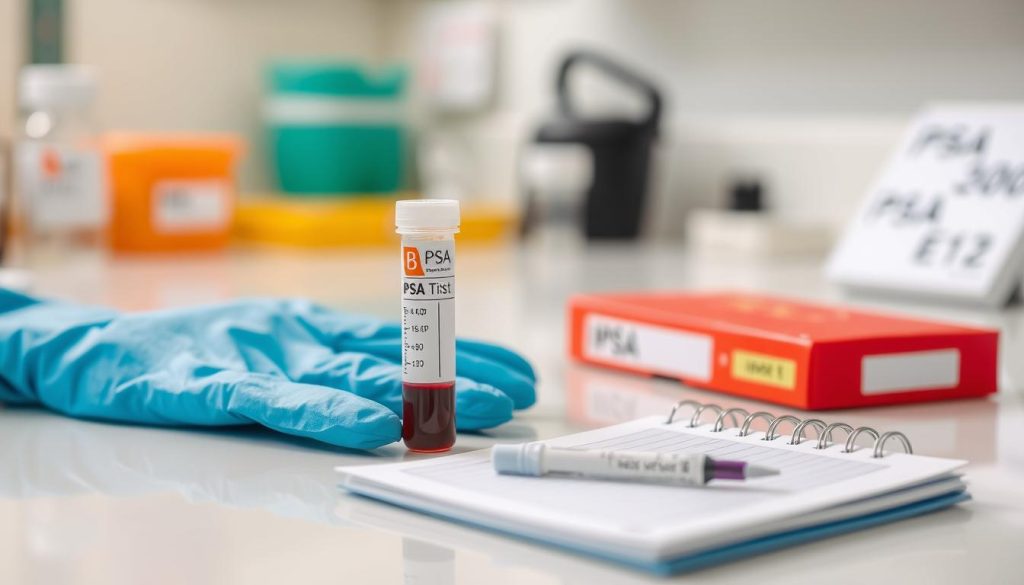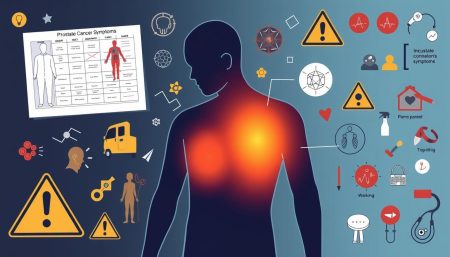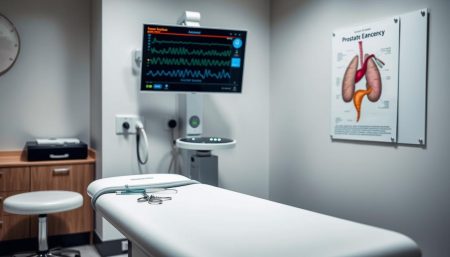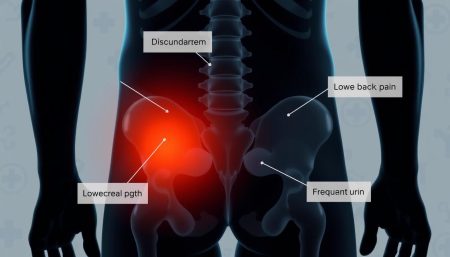Spotting the early signs of prostate cancer is key to getting timely treatment. It’s one of the most common cancers in men. Knowing prostate cancer symptoms is vital for men’s health.
Prostate cancer often grows slowly, with small changes that might not be noticed. Knowing these early signs can help catch the cancer early. This means better treatment options. The body gives hints, like changes in how you pee or feeling uncomfortable.
In this guide, we’ll look at prostate cancer signs, from small changes to more obvious symptoms. Learning what to watch for helps you take care of your health. It also means you’ll know when to see a doctor.
Understanding Prostate Cancer Basics
Prostate cancer detection starts with understanding the basics. Let’s explore the prostate gland, how cancer develops, and key risk factors. This will help you see why prostate cancer screening is important.
What is the Prostate Gland?
The prostate is a small, walnut-sized gland in men. It sits below the bladder and surrounds the urethra. This gland is key in producing seminal fluid, which helps sperm.
How Cancer Develops in the Prostate
Cancer happens when prostate cells grow out of control. These abnormal cells can form tumors and spread. Early screening is key to catch these changes early.
Risk Factors and Demographics
Certain factors increase the risk of prostate cancer. Age is a big factor, with risk rising after 50. Family history and race also matter. African American men face higher risks and may need earlier screening.
| Risk Factor | Impact on Prostate Cancer Risk |
|---|---|
| Age | Risk increases significantly after age 50 |
| Family History | 2-3 times higher risk if a close relative had prostate cancer |
| Race | African American men have 60% higher risk than white men |
| Diet | High-fat diets may increase risk by 20% |
Understanding these basics is key for effective prostate cancer detection. Regular screening, for high-risk groups, can lead to early diagnosis and better treatment.
Common Signs of Prostate Cancer
Spotting prostate cancer early is key to good treatment. Some men might not feel symptoms early on. But, others may notice warning signs. Knowing these signs can lead to quick medical help.
Changes in how you pee can be a sign. You might pee more often, or have trouble starting or stopping. A weak or broken urine flow is another warning.
Sex life changes can also hint at prostate cancer. Issues like not being able to get an erection or different ejaculation patterns are signs. Some men might feel pain during sex.
Pain in your pelvis, lower back, or hips could mean prostate cancer. You might also see blood in your pee or semen.
| Category | Signs of Prostate Cancer |
|---|---|
| Urinary Changes | Frequent urination, weak flow, difficulty starting/stopping |
| Sexual Function | Erectile dysfunction, changes in ejaculation |
| Pain/Discomfort | Pelvic area, lower back, hips |
| Other Symptoms | Blood in urine or semen |
Remember, these symptoms can also mean other health issues. If you notice any, see a doctor for a check-up and diagnosis.
Urinary Changes and Symptoms
Urinary changes are often the first signs of prostate cancer in men. These changes can start small but grow over time. Knowing these early signs is key for early detection and treatment.
Frequent Urination Patterns
Men with prostate issues often go to the bathroom more, even at night. This can mess up sleep and daily life. If you’re up a lot at night, see a doctor.
Difficulty Starting or Stopping Urination
Prostate cancer can make the gland grow, pressing on the urethra. This can make it hard to start or finish urinating. Some men feel a sudden need to go, then have a weak stream or dribble.
Weak or Interrupted Urine Flow
A weak urine stream is another sign of prostate trouble. Your urine might not flow as well as before, or it could stop and start. This symptom can get worse if not treated.
| Urinary Symptom | Description | Action |
|---|---|---|
| Frequent Urination | Increased bathroom visits, even at night | Track how often and talk to a doctor if it keeps happening |
| Difficulty Starting/Stopping | Hard to start or finish urinating | Get medical help for a check-up |
| Weak Flow | Urine stream is not as strong | Watch for changes and talk to your doctor |
These urinary changes can mean prostate cancer, but they might also point to other issues. It’s important to talk to your doctor about any lasting symptoms for the right diagnosis and care.
Sexual Function Changes
Prostate cancer can change a man’s sexual health. It’s key to know the signs of prostate cancer related to intimacy. Spotting these changes early can help in getting the right treatment.
Erectile Dysfunction
Difficulty getting or keeping an erection is a common sign of prostate cancer. Many things can cause erectile dysfunction. But, if it keeps happening, talking to a doctor is a must.
Changes in Ejaculation
Prostate cancer can also change how you ejaculate. You might notice less semen, pain, or blood in your semen. Seeing a doctor right away is important.
Impact on Sexual Performance
Prostate cancer can also affect how you perform sexually. You might feel less interested in sex or have trouble reaching orgasm. These issues can really affect your life and relationships.
Remember, having these symptoms doesn’t mean you definitely have prostate cancer. But, they are signs to talk about with your doctor. Talking openly about your sexual health can help find prostate cancer early. This can lead to better treatment options.
Pain and Discomfort Indicators
Pain and discomfort can signal prostate cancer, mainly in advanced stages. These symptoms show up in certain body areas and can vary in how bad they are. Spotting these signs early is key for catching the disease and treating it.
Lower back pain is a common sign of prostate cancer. It can feel like a dull ache or a sharp, intense pain. Hip and pelvic pain may also show up as the disease gets worse. These symptoms can be easy to miss or think of as something else, so it’s important to watch for them.
Signs of advanced prostate cancer include bone pain, often in the spine, ribs, or pelvis. This happens when cancer spreads to the bones, known as metastasis. You might also lose weight without trying or feel very tired.
| Pain Location | Description | Associated Symptoms |
|---|---|---|
| Lower Back | Dull to sharp pain | Stiffness, limited mobility |
| Hips | Aching or throbbing | Difficulty walking |
| Pelvis | Pressure or discomfort | Urinary issues |
| Bones | Deep, constant pain | Fractures, weakness |
If you have ongoing pain in these spots, and it’s with other signs of prostate cancer, see a doctor right away. Catching it early can make a big difference in how well you can be treated and how good you’ll feel.
Early Warning Signs vs. Advanced Symptoms
It’s important to catch prostate cancer early for better treatment results. As the disease gets worse, symptoms can worsen and affect daily life. Let’s look at the different stages of prostate cancer symptoms.
Initial Warning Signs
Early prostate cancer signs are often mild and can be confused with other issues. These include:
- Frequent urination, often at night
- Weak or interrupted urine flow
- Difficulty starting or stopping urination
- Blood in urine or semen
- Erectile dysfunction
Progressive Symptoms
As cancer grows, symptoms become more obvious:
- Persistent pain in the lower back, hips, or pelvis
- Unexplained weight loss
- Fatigue
- Changes in bowel habits
Late-Stage Indicators
Severe symptoms of advanced prostate cancer include:
- Bone pain, often in the spine, ribs, or hips
- Weakness or numbness in the legs or feet
- Loss of bladder or bowel control
| Stage | Symptoms | Action |
|---|---|---|
| Early | Subtle urinary changes, erectile issues | Regular screening, consult doctor |
| Progressive | Pain, weight loss, fatigue | Immediate medical evaluation |
| Advanced | Severe pain, neurological symptoms | Urgent oncology care |
Knowing how prostate cancer progresses helps in early detection and treatment. If you notice any concerning symptoms, get medical advice right away.
The Importance of Prostate Cancer Screening
Prostate cancer screening is key for men’s health. Finding cancer early can greatly improve treatment success and survival chances. Regular checks help spot cancer before symptoms show, leading to quicker action.
These tests together give a full view of prostate health. The PSA test looks at a protein from the prostate. The DRE lets doctors feel for any oddities.
| Screening Method | Frequency | Age to Start |
|---|---|---|
| PSA Test | Annually | 50 (earlier for high-risk men) |
| DRE | Annually | 50 (earlier for high-risk men) |
Men with a family history of prostate cancer or African American men might start screening sooner. It’s important to talk to your doctor about your risk factors. This will help figure out the best screening plan for you.
Remember, screening for prostate cancer can save lives. Don’t wait for symptoms. Take control of your health by getting regular screenings with your healthcare provider.
PSA Testing: Understanding Your Numbers
PSA testing is key in prostate cancer screening. Knowing your prostate-specific antigen levels can spot problems early. Let’s look at what these numbers mean and when to get tested.
Normal PSA Ranges
PSA levels change with age. Doctors use these guidelines:
| Age Group | Normal PSA Range (ng/mL) |
|---|---|
| 40-49 years | 0-2.5 |
| 50-59 years | 0-3.5 |
| 60-69 years | 0-4.5 |
| 70+ years | 0-6.5 |
Factors Affecting PSA Levels
Many things can change prostate-specific antigen levels:
- Age
- Prostate size
- Recent ejaculation
- Urinary tract infections
- Certain medications

When to Get Tested
When to start PSA testing varies. Talk to your doctor about starting screenings:
- Age 50 for average-risk men
- Age 45 for high-risk men (African American or family history)
- Age 40 for men with multiple close relatives diagnosed with prostate cancer
Remember, PSA testing is just one part of prostate cancer screening. Regular check-ups and talking with your healthcare provider are vital for prostate health.
Digital Rectal Examination (DRE) Process
The digital rectal exam is key in finding prostate cancer. It’s a simple way for doctors to check the prostate gland for any issues. During the exam, a healthcare provider uses a gloved, lubricated finger in the rectum to feel the prostate’s size, shape, and texture.
A typical DRE only takes a few minutes and is often done with other tests. It might cause a bit of discomfort, but it’s usually painless. Many men worry about it, but knowing its importance can help calm their nerves.
It’s important to remember that a DRE alone can’t confirm prostate cancer. If the doctor finds anything suspicious, they might suggest more tests. These could include a PSA blood test or a prostate biopsy.
| DRE Findings | Possible Indications |
|---|---|
| Smooth, firm prostate | Typically normal |
| Hard or lumpy areas | Potential cancer |
| Enlarged, soft prostate | Possible benign prostatic hyperplasia (BPH) |
| Tender prostate | Potential prostatitis |
Regular DREs and PSA tests are key to watching over prostate health and catching cancer early. Men should talk to their doctors about when to start screening. This depends on their risk factors and age.
Risk Assessment and Family History
Knowing your risk for prostate cancer is key to catching it early. Your genes, environment, and lifestyle all affect your risk. By understanding these, you can spot prostate cancer warning signs sooner and take care of your health.
Genetic Factors
Family history is a big deal when it comes to prostate cancer risk. If your relatives have had it, you might too. Genes like BRCA1 and BRCA2 can also up your risk. So, if you have a family history, getting screened regularly is a smart move.
Environmental Influences
Some chemicals and radiation can up your risk of prostate cancer. Workers in certain jobs and people living in polluted areas might be at higher risk. Environmental factors can affect many cancers, so staying informed is important for your health.
Lifestyle Considerations
Your daily choices can also affect your risk. Eating lots of fruits and veggies might help, but eating too much red meat might not. Staying active, keeping a healthy weight, and not smoking or drinking too much alcohol are all good for you.
| Risk Factor | Impact Level | Preventive Action |
|---|---|---|
| Family History | High | Regular screenings |
| Chemical Exposure | Moderate | Protective equipment use |
| Diet | Moderate | Balanced nutrition |
| Physical Activity | Moderate | Regular exercise |
Age-Related Prostate Changes
As men get older, their prostate glands change. These changes can look like prostate cancer, so it’s key to know the difference. Getting regular prostate cancer screenings is more important as you age.
The prostate often gets bigger with age, a condition called benign prostatic hyperplasia (BPH). This growth can cause urinary symptoms that might seem like prostate cancer. But, BPH doesn’t raise your risk of getting prostate cancer.
Here’s a comparison of common age-related prostate changes and signs of prostate cancer:
| Symptom | Age-Related Change | Potential Cancer Sign |
|---|---|---|
| Urinary Frequency | Gradual increase | Sudden, significant change |
| Urinary Flow | Weaker stream over time | Abrupt weakening or interruption |
| Pain | Mild discomfort | Persistent, severe pain |
| Blood in Urine | Rare, often due to other causes | More common, requires immediate attention |
While age-related changes are normal, it’s important to watch your prostate health. Regular prostate cancer screenings, like PSA tests and digital rectal exams, can tell the difference. Talk to your doctor to set up a screening plan that fits your age and risk.
When to Consult a Healthcare Provider
It’s important to know the signs of prostate cancer and get medical help early. This can lead to better treatment and health outcomes. Knowing when to see a doctor is key to taking care of your prostate.
Emergency Warning Signs
Some symptoms need urgent care. If you have any of these, go to the emergency room right away:
- Severe pain in the lower back or pelvic area
- Difficulty urinating or complete inability to urinate
- Blood in urine or semen
- Unexplained weight loss or fatigue
Scheduling Regular Check-ups
Regular visits to your doctor are important for catching prostate cancer early. Men should talk to their doctor about screening at:
- Age 50 for those at average risk
- Age 45 for African American men or those with a family history
- Age 40 for men with multiple close relatives diagnosed with prostate cancer
At these visits, your doctor might suggest PSA tests or digital rectal exams. These help keep an eye on your prostate health. Early detection is vital for managing prostate cancer well.
Diagnostic Tools and Procedures
Doctors have many advanced tools to find prostate cancer. After first tests, they might suggest more tests to be sure. These tests include detailed imaging that shows your prostate clearly.
A prostate biopsy is a common test. It involves taking small tissue samples from your prostate. These samples are checked for cancer cells. It might sound scary, but it’s key to getting a correct diagnosis.
Other tests like MRI scans give detailed images of your prostate. These scans help find areas that might need more checking. Sometimes, they help guide the biopsy, making it more accurate. These tools and tests are important for finding prostate cancer and planning treatment.
FAQ
Q: What are the early signs of prostate cancer?
A: Early signs of prostate cancer include frequent urination and trouble starting or stopping. You might also notice a weak urine flow or blood in urine or semen. Some men experience erectile dysfunction or discomfort in the pelvic area. Remember, these symptoms can also be from other health issues, so seeing a doctor is key.
Q: At what age should men start getting screened for prostate cancer?
A: Men should talk to their doctor about prostate cancer screening by age 50. If you’re African American or have a family history, start the conversation at 45 or younger. This is to catch any issues early.
Q: What is a PSA test and what do the results mean?
A: A PSA test checks for prostate-specific antigen in your blood. Normal levels are usually under 4 ng/mL. But, many things can affect your PSA, like age and health conditions. If your levels are high, it might mean cancer, but it could also be other issues. Always talk to your doctor about your results.
Q: How is prostate cancer diagnosed?
A: Doctors use a PSA test, digital rectal exam, and sometimes imaging to find prostate cancer. A biopsy is needed to confirm cancer by looking at prostate tissue under a microscope.
Q: Can prostate cancer be prevented?
A: Preventing prostate cancer is hard, but healthy habits can help. Eating well, exercising, staying at a healthy weight, and not smoking are good choices. Regular check-ups and screenings are also important for catching cancer early.
Q: What is the survival rate for prostate cancer?
A: Prostate cancer survival rates are high, thanks to early detection. The 5-year survival rate is 98% for all stages. But, survival depends on when cancer is found and individual health. Regular screenings are key to better outcomes.
Q: How does family history affect prostate cancer risk?
A: Family history greatly increases prostate cancer risk. Men with a family history are twice as likely to get it. The risk goes up if many relatives had it or were diagnosed young. Talk to your doctor about your family history to plan screenings and prevention.
Q: What are the treatment options for prostate cancer?
A: Treatment choices depend on cancer stage, PSA level, and overall health. Options include active surveillance, surgery, radiation, hormone therapy, and sometimes chemotherapy. New treatments like immunotherapy and targeted therapy are also available. Your treatment plan will be made by a team of healthcare providers.


















